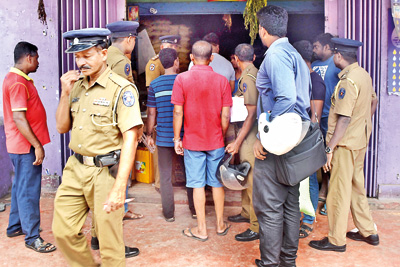News
Govt. plans to buy rice to counter runaway ‘mafia’ prices
Desperate to manage runaway prices prescribed by “a mafia”, the government has floated a plan to buy rice from private millers to be distributed among consumers at “reasonable prices” as a short-term measure.

Jaffna: A raid being carried out at a shop selling rice at prices above the stipulated amount
Once again, the “rice mafia” backed by politicians and government officials were blamed for the prevailing situation where nadu and samba varieties are both selling at Rs. 98 a kilo.
Although this is the controlled maximum retail price imposed by the Consumer Affairs Authority (CAA) it can be made lower, All-Island Farmers’ Federation National Organiser Namal Karunaratne said.
“If you apply the rice price formula, varieties such as nadu and samba can sell for between Rs. 74 and Rs. 88,” Mr. Karunaratne said.
In addition to short-term solutions, the government wants to provide stores to farmers in which to stack their harvest, Member of the Cabinet Subcommittee on the Cost of Living Vidura Wickramanayaka said.
He disclosed that President Gotabaya Rajapaksa was, in fact, looking at whether the maximum retail price could be taken down further than the current Rs. 98 level.
The government is also set on devising a scientific method of gathering data and paddy harvest statistics as well as the country’s rice requirement.
“According to the statistics provided by the authorities, Sri Lanka should have a surplus of rice but we do not see that in the market,” Mr. Wickramanayaka said.
“Either the statistics are wrong or the millers and merchants are hoarding paddy and rice.”
Comprehensive information was crucial to designing a lasting solution, he said.
The price of rice skyrocketed from Rs. 110 to Rs. 115 in recent weeks, forcing the CAA to issue an Extraordinary Gazette imposing a maximum retail price of Rs. 98 for a kilo of samba and nadu.
A researcher told the Sunday Times that while previous governments had been provided with sufficient information and data they had consistently made decisions that favoured influential businessmen and millers. Politically-appointed officials in some state institutions had deliberately avoided action that could have led to price decreases.
Previous administrations did not buy or maintain large stocks of paddy, he said, requesting anonymity. Even the Paddy Marketing Board had purposely allowed private millers to hoard stocks and continue their monopoly over prices without buying the bigger portion of harvests as they are mandated to do.
“Politicians win elections by getting money from the big businessmen such as mill owners,” the analyst said. “When they become ministers, they allow these businessmen to earn as they too can profit and even get financial support for future elections.”
The main reason for the hike in rice prices is inactive small and mid-scale mills, countered B.K. Ranjith, President of the All-Island Small and Middle-Scale Rice Millers Association.
Where there were previously 1,000 such mills in 11 districts, most were now either shut or
on the verge of closure. Only 300 were still in operation.
Large-scale mills with large stores are the first to buy the paddy during harvest and collect much of it from farmers at prices below government prices, he said.
“As result, we small-time millers have to buy paddy for high prices after demand rises,” Mr. Ranjith said. “And even if we manage to purchase a large quantity, we have no stores so cannot mill rice every day.”
He said the major millers hoard paddy and release small amounts of rice, ensure that prices always remain high or rise higher.
Even the banks support the large-scale millers as they are able to repay loans, Mr. Ranjith said. Small-timers end up in debt or lose their mills. “If the Government supports us, we can bring back the 1,000 small and middle-scale mills and supply 60 per cent of the country’s requirement,” he insisted.

